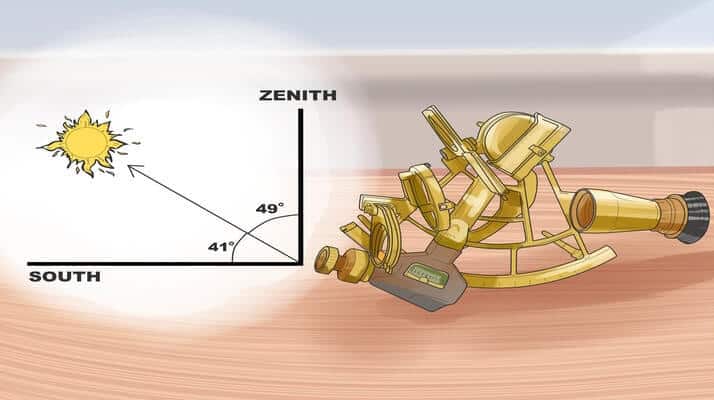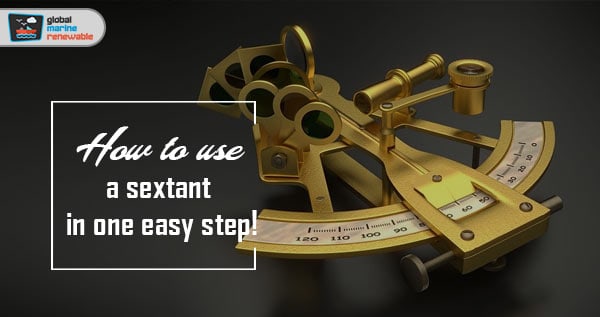Talking about navigation features, there are many things on boats that we use, and we do not know the name, or we do know the name but we just don’t know how to use it, and one of them is the sextant.
Many people tend to get confused with this device thinking it is a telescope because it has almost the same function but has different structures.
A sextant is an architectural apparatus that measures the dimension of two objects.
It is commonly used while navigation because it offers great precision while watching the sky or the stars at night.
When you see it for the first time, it looks like it is difficult to use but actually, it is not, you just have to read the instructions before. It consists of mirrors, a movable arm, a 60-degree wooden arc, and a small scope.
People use it during trips and navigations to see the moon or the sun instead, but it is important to know that for solar examination it has some filters to avoid any solar damage in the eyes.
Some investigations have demonstrated that Isaac Newton invented a device, a reflecting quadrant, but it was never published.
A few years later, two men invented a similar apparatus called the octane in 1730.
See Also:
Table of Contents
How Does A Sextant Work?
The sextant has two mirrors incorporated, one of them allows to pass some light through it while you are navigating. This one it is half-silvered.
When you are in the boat, you look at the horizon through this mirror. The other one is connected to the arm.
This arm can be moved depending on the horizon of the sun.
How To Use A Sextant

The sextant has many advantages, and one of them is that it can be used for several things such as; finding the angle elevation for a specific object.
It is important to know your elevation above sea level.
There are 7 major key components in a sextant. It basically consists of a telescope, index mirror, shades for index mirror, horizon mirror, arc, and micrometer head.
By manipulating the moving arm on which the index mirror is fixed, a star or other celestial structure can be made visible on the horizon. To get an accurate adjustment, the micrometer knob is necessary.
Here’s how to use it;
Finding The Angle Elevation – Uses of A Sextant
- Look the horizon by watching through the mirror.
- Move the sextant’s arm until the object you’re trying to see is also visible on the horizon.
- After having found the objects you wanted to see, clamp the index arm in order to block it from any movement.
- Record the time in which you made your view. It is important in navigation as it helps you to know where is your horizon.
- Record the angle measurement.
- Correct the angle measure according to your position and the object you want to watch.
Finding Your Latitude In Daytime
- First, you have to find the sun’s angle at its highest point which is right around noontime on your watch.
- Then, you have to find the latitude of the sun depending on the references table that should have on the day you’re observing.
Finding Your Latitude In The Night Time
- Find the North Star and its latitude with the device.
A long time ago, people started to use this device as a professional method to know more about the sky and its curiosities.
Celestial Navigation has been one of the most interesting practices during sailing trips.
It’s a process where angles between two objects in the sky are situated in one’s position globe according to the nautical almanack.
To have a successful Celestial Navigation, it is important to know how to use the sextant, have common sense, and know how to calculate the dimensions.
Because somehow, the celestials’ objects will be located directly over a particular position on earth.
Principal Of The Sextant
The basic principle of the sextant is “If a ray of light is reproduced from two mirrors in sequence then the viewpoint between the first and last direction of the ray is twice the viewpoint between the mirrors.”
The viewpoint can be read of the arc.
Errors & Adjustments
The device is a subject of error and adjustments. Please refer to the researches done by Mr. Eugene Griessel to know more.
In short, to find out the true altitude these following functions must be allowed and adjusted.
- Index Error.
- Dip.
- Refraction.
- Parallax.
- Semi-diameter.
Uses of A Sextant FAQ
Q1. What derives the name of the device?
It comes from the arc at the bottom which is one-sixth of a circle.
Q2. Why is it so useful?
For its precision, and for providing so much information about celestial objects.
Q3. Which are the parts of the sextant?
Telescope, index mirror, shades for index mirror, horizon mirror, arc and micrometer head.
Q4. If we are navigating, does the sextant lose its horizon?
No, the horizon and celestial objects stay permanent when it is viewed through the sextant because it sees them between two opposite mirrors that subtract the motion from the reflection.
Q5. Is it necessary to use a chronometer?
Yes, it can help you out to find your longitude.
Q6. What’s the difference between sextant and astrolabe?
Astrolabe is a astronomical instrument. On the other hand, Sextant is a angle measurement instrument.
Uses of A Sextant Conclusion
In general, we can say the sextant is a device which has been used for many years in boats as a hobby and for professional use by helping people to find their latitude while navigating.
Besides, it provides you with an incredible view, on days and nights.
It is not that easy to use, but reading some of the instructions papers, you can use it successfully.
